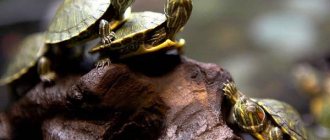If you decide to get a turtle...
Imagine for a moment if you could live not in a house with a roof over your head, but in a dwelling in the open sky? Likewise, pets, especially reptiles, do not tolerate lack of proper attention towards themselves. When arriving at a pet store, it is unlikely that every buyer expects to purchase all the essentials at once, since keeping a pet costs a tidy sum.
Having bought a sea turtle, at first glance it may seem that it will feel great in a shallow jar, basin or trough. From this first illusion that the potential owner creates for himself, his irresponsibility is born. If you decide to get a turtle, immediately provide it with an aquarium of the required size. The place should be vulnerable to sunlight. A stable surface is the most important condition, otherwise, with slight disturbances, the aquarium with a turtle may collapse and break.
Types of water turtles
For those wishing to have a pet, I recommend that you consider purchasing a sea turtle. These include:
- red-eared - got its name because of the red spots in the eye area. Habitat: South America, Mexico, Great Britain, Spain. The animal has a bright color: wavy stripes of white-green color located on the shell, neck, and head. Length up to 30 cm. Under natural conditions, lives in wetlands of lakes and ponds. Sedentary and lazy.
Pond slider - Bolotnaya. Habitat: Russia, Belarus, Ukraine, Moldova, Armenia, Lithuania. For habitat it chooses reservoirs with a muddy bottom. Features of the color are yellow blotches on a dark green shell. Length - up to 35 cm.
Swamp turtle - Long neck - got its name for its long neck, which allows it to instantly grab prey. Habitat: south-eastern United States. Lives in stagnant bodies of water. It has an oval shell up to 26 cm long.
Long-necked turtle - Silt musk has musk glands under its shell, which determine its name. Habitat: South America. Peculiarities of color are interspersed with light shades on the dark shell and head. Length from 7 to 13 cm. Excellent swimmers. In natural conditions - reservoir orderlies.
Mud turtle
Who is a sea turtle suitable for?
In nature, there are many species of sea turtles, which differ in size and habitat characteristics. Not all of them are suitable for keeping in a home aquarium: a turtle that is too large will not be able to live for long outside the wild without a large space, but small and medium-sized turtles adapt perfectly to life in a house or apartment. They are bred to be kept outside of nature, so from the moment of hatching they, as a rule, practically cannot be in the sea or ocean. Thus, for keeping at home, you can purchase a marsh, red-eared or Caspian turtle. The first type can be found in the nearest body of water, the other two can be purchased at a pet store.
At first glance, a sea turtle causes more trouble for the owner than a land turtle, because weekly cleaning of the aquarium and changing the water becomes a prerequisite. But the owner of the turtle quickly gets used to it and performs all actions automatically. Pets require a lot of space, so the owners of a cramped apartment are unlikely to be able to give turtles a decent corner. But this is not a reason to give up your dream pet: miniature turtles will feel quite comfortable in a small aquarium.
Psychologists say that having any pet makes a person more caring and balanced. Quiet creatures, turtles will give peace and tranquility to their owner, as soon as he looks at their peaceful and carefree existence. Unlike a cat or dog, they practically do not make themselves known, but this is not a reason to forget about their presence: leave yourself reminders to feed the turtles and change the water on time.
What kind of aquarium should a turtle have?
It is an aquarium, and not a terrarium, that should be chosen for a sea turtle. Most of the time they are in the water, and sometimes they do not come onto land at all. For a large turtle, you should buy a large home in which it will not lack space and can swim. Small turtles can get by with a small aquarium. An important condition in maintaining proportions: the width of the aquarium (or length) must be twice the height. Even the smallest turtle requires an aquarium with a volume of at least 10 liters, while for a large one it is necessary to stock up on a capacity of 400 liters. Since the water must be changed at least twice a week, this creates inconvenience for owners of apartments and private houses, because not every area is supplied with clean water. In this case, you should stock up on a cleaning system and use an aquarium filter.
Keep in mind that turtles grow quickly, so you will have to be patient and change the tank as your pet grows. Remember that you can always return your pet's property to the pet store where you are served, or change the equipment to more spacious one for an additional fee. A small turtle will not feel comfortable in an overly large container, so you will have to buy turtle friends for it or choose a small aquarium.
How to feed your pet
The sea turtle's diet is varied:
- artificial food;
- fish;
- fish food;
- vegetables;
- insects;
- plants for the aquarium.
But with all the variety, it is necessary to control so that the reptile does not overeat. For this purpose, it is recommended to use a calcium diet from time to time. The pet loves to hunt for its prey, but does not refuse carrion. The main thing is to remember to add calcium to your menu. The turtle does not produce saliva while eating, so it pulls the food into the water. You can use this for your own benefit, that is, feed your pet in another container with water, then the water in the aquarium will remain clean longer.
It is important to know that the older the turtle, the more plant foods it eats and the less protein. Therefore, the diet of an adult or old turtle consists of 25% protein and 75% plant foods.
Arrangement of the aquarium
Despite the fact that sea turtles are in the water almost all the time, they occasionally go onto land, so the design of the aquarium should include a so-called shore. The material from which you plan to make the ledge should not be slippery, otherwise the turtles may have problems climbing onto it. Try to use natural or close to natural material, such as stone.
Being in a deep aquarium, sea turtles do not even think about escaping, but at the first opportunity they do not deprive themselves of the pleasure of crawling out. Take this into account when making the bank and leave at least 30 cm of height to the edge of the aquarium. The projection area should not exceed 25% of the total space. Newborn turtles will develop best in a warm, dry place, such as a box. The so-called maternal instinct is developed only in one species of turtles; the physiology of the rest does not provide for caring for the offspring. A water temperature of 31˚C is considered the most optimal. To monitor, you will have to install a thermometer. Heating the water is not necessary if the incandescent lamp is constantly on above the bank.
Water requirements
The red-eared turtle is a waterfowl reptile. She feeds, defecates, and sleeps in water. Therefore, water should always be clean and fresh. Dirty food causes discomfort to the pet and is a source of disease.
The lowest water level in a container is measured by the size of its shell. She should calmly roll over onto her stomach if she ends up on her back. But the declared level is the lowest. Ideally, more water is recommended, then it stays clean longer.
When changing water, it must be left for 24 hours. It is important to ensure that the water does not drop to 20 degrees, but is between 22–28 degrees. If it is necessary to heat the water, install a heater. The water temperature is controlled using a thermometer.
Since the pet performs all its physiological needs in the aquarium, the water becomes dirty and smells unpleasant. To avoid this, change the water once every 7 days. To perform this procedure less frequently, you need to install a filter. The internal filter does not cope with water after the turtle, it is weak. Of course, you can buy an external filter, it fits perfectly, but its price is not cheap.
What is an ultraviolet lamp for?
In the wild, any sea turtles, after a long stay in the water, love to bask in the sun's rays. At home, it is not recommended to choose a place near a source of bright sunlight. An ultraviolet lamp is an excellent alternative for sea turtles, which require ultraviolet radiation for full development. This personal “home sun” should not be located closer than 30 centimeters above the aquarium. In the first days after you have one or more sea turtles, ultraviolet irradiation is carried out a couple of times a week for 5-10 minutes. The duration of the procedure should gradually increase. It is important to know that an ultraviolet lamp, which is used in medicine, is absolutely not suitable for turtles as a source of ultraviolet radiation.
Place where the reptile is kept
Before purchasing a reptile, you need to take care of its place of residence.
The reptile should be kept in an aquarium. Its width should be twice as large as its height, and its volume should be at least 150 liters. Even if the reptile is small, it will grow very quickly, so this size of the aquarium will be ideal.
The container should be equipped. For a good life for a reptile, it is necessary to pay special attention to the contents of the aquarium. It must contain:
- an island of land - the turtle will need it for rest. In addition, many people like to crawl out of the water and walk. Dry land should occupy a quarter of the aquarium. It should be placed away from the edge, otherwise the reptile may escape. It is better to purchase a rough, flat bank, because the pet will slide off the plastic island;
- incandescent lamp - it will serve as a kind of sun and heat the turtle when it is resting on land. It should be placed so that when the reptile dives, splashes do not fall on it;
- thermometer – it will show the temperature under the lamp to prevent your pet from overheating. The optimal temperature will be 30-35 degrees; if higher, the turtle may get burned;
- A UV lamp will help your pet absorb calcium and produce vitamin B. Without it, the reptile will quickly develop rickets. The UV lamp should be placed above the turtle and turned on for 12 hours a day.
The amount of water should be enough for the reptile to swim and flip over comfortably. Since all physiological processes take place in water, it quickly becomes polluted.
IMPORTANT! Dirty water is a source of disease. The water should be changed every 5-7 days. Before this, it should be defended for a day.
Sea turtle nutrition
Before you decide to get a pet, it is important to find out what sea turtles eat in advance. Turtles are not the most capricious reptiles, but if they refuse their usual food, you should offer them another treat, for example, guppy fish. Having these and other fish will prevent you from having to visit the pet store at inopportune times, and it is much more fun to raise fish and turtles at the same time. Little turtles require food every day, which has a positive effect on their growth and development. Older individuals can go without food for three days.
Sea turtles' diets should include chopped vegetables and lean beef and chicken. The ideal option is crushed boneless fish, sea cocktail, snails. All food must be served exclusively raw. Dry food, which is cheaper in cost than fresh food, should not become the main food for turtles. It is recommended to add vitamins and minerals to the diet for variety, which will ensure the healthy development of your pets, because being outside the will, turtles do not have the opportunity to get all the necessary elements.
Sea turtles feed not in an aquarium, but in a separate place. If food is given in an aquarium, you cannot avoid contamination of the water. The amount of food eaten necessary for the development of a turtle is determined in the first days after its appearance. To do this, you need to leave the turtle with a large dose of food. The amount that your pet eats in the first half of the day will become the daily norm.
What you need to know when purchasing
Show each new pet to a veterinarian and quarantine it before allowing it into the main terrarium. When purchasing
a pet, it is advisable to take it to a veterinarian for examination in order to rule out the presence of disease or injury. If you are not purchasing the first inhabitant for your aquatic terrarium, then take care of a 3-month quarantine for the new one in a separate aquarium.
Try not to keep adult and baby turtles together, as adults often injure babies. It is better to purchase individuals of the same size.
Caring for baby turtles
Adding a new pet to the family is always a joyful event that requires a responsible approach on the part of the owner. Caring for newborn turtles falls entirely on the shoulders of the owner, since the maternal instinct in turtles is not developed. Despite having a strong shell, small turtles are incredibly delicate, so any damage to the outside can negatively affect their health. There is a high mortality rate among sea turtle hatchlings, so if the baby shows any signs of a change in appearance or behavior, you should take it to a veterinarian.
Small sea turtles are so shy that death can result from severe fright. It is not recommended to pick up the cubs or knock on the glass of the aquarium. After arriving at a new place, the pet should get used to it, so for the first few days it should not be disturbed. If you have not previously dealt with turtles, you should study the features of their anatomical structure. On the yellow belly of the turtle, called the plastron, there is a small pouch that contains nutrients for the baby. It disappears as the turtle grows up, this usually happens in the second month, when the turtle begins to eat fully. Baby sea turtles are more susceptible to waterborne diseases, so it should not stagnate in the aquarium for more than two days. The water temperature should not be 5˚C higher than the norm, which should be taken into account when keeping adult turtles, that is, on average it is 26-27˚C.
What to do if a sea turtle gets sick?
There are two sources of colds in turtles. In the first case, the turtles bring it home from the pet store, in the second, they begin to get sick for the first time in their new home conditions. The first symptoms of a cold include refusal to eat, cough, and low activity. In some cases, your turtle may experience swelling in the head area and flaking of the skin. If these or other signs of illness appear in a sea turtle, it should be immediately taken to a veterinarian, who will determine the cause of the illness and recommend methods to combat it.
Small turtles suffer from colds especially hard, since against the background of the first symptoms, some others may develop that are not related to the disease. A turtle with a cold stops taking care of itself and shows passivity when having fun. Remember that you cannot save on your pet’s condition if you want the money invested in care to always be worth it and for your sea turtle to always be with you. Care at home can extend your pet's life up to 50 years, although on average turtles live about 30 years. By the way, 150-year-old individuals were often caught in nature.
Health, disease and prevention
As a rule, most pets, including the red-eared turtle, get sick in most cases due to improper care and maintenance. Dirty and untreated water quickly leads to the fact that the turtle begins to feel unwell, as many harmful microorganisms appear in it. In this case, it is necessary to raise the temperature in her home by a couple of degrees in order to optimize the functioning of the immune system. It is also necessary to ensure that the animal does not experience a lack of moisture (water), otherwise, against this background, kidney failure begins to develop, leading to disastrous consequences.
The fact that something is wrong with the turtle may be indicated by its behavior. When it swims, it can fall on its side or even sink to the bottom. If there is a suspicion of infection, then it is advisable to treat all items for caring for the reptile with an antiseptic that will not cause harm to the animal. Symptoms of bacterial damage are associated with the appearance of edema and necrotic changes. Such diseases require the use of antibiotics for treatment. In this case, you will have to completely replace the water in the aquaterrarium.
If a turtle is injured, an infection can enter its body, leading to blood poisoning. As a result, the animal’s paws turn red, and the turtle becomes quite lethargic and inactive. This type of disease is practically not curable, especially on its own, so you will have to visit qualified specialists. If treatment for your pet is not started in a timely manner, the outcome can be very disastrous.
To prevent this from happening, it is necessary to take preventive measures, such as:
- Inspect your turtle daily.
- Clean the aquaterrarium regularly.
- Change the water regularly.
- Organize proper healthy nutrition.
- Avoid hypothermia.
- Monitor the operation of the heating, lighting and filtration systems.
- Observe personal hygiene rules.
- From time to time, clean the turtle's shell of algae.
- Adhere to the rules for keeping sick or newly purchased animals (quarantine regime).
- Avoid contact of a sick animal with both family members and pets.
- Constantly monitor the turtle's movements outside its home.
- Periodically turn on the UV lamp and expose it to sunlight.
- From time to time, show the animal to a veterinarian.
In case of improper nutrition, the turtle begins to experience a lack of calcium, which leads to curvature and softening of the shell. If there is too much calcium deficiency, your pet may die. In such cases, the veterinarian prescribes drugs with a high calcium content in injections. It is also necessary to know that calcium is absorbed due to the presence of vitamin D in the animal’s body. Vitamin D is produced as a result of UV exposure, so it is very important to regularly turn on the UV lamp.
Pond slider. House maintenance. Interesting Facts.
The amazing world of sea turtles
Scientists are still searching for an answer to the question of the origin of turtles. From the myth it is known that the globe was supported by a giant turtle, the ancestor of which remains unknown. A 220-million-year-long mystery remains unsolved—that’s how long turtles have inhabited planet Earth.
- Sea turtles have excellent memory and, after long journeys, can return to the place where they were born. This is due to their ability to navigate the Earth's magnetic field.
- 100 million years - this is exactly how much time has passed since the emergence of leatherback sea turtles, which are recognized as the oldest.
- Leatherback turtles are capable of living in waters more than a kilometer deep.
- Green turtles and turtles can weigh up to half a ton.
- In order to find a suitable place to lay eggs, turtles can swim 20 thousand kilometers.
- A female sea turtle can lay 1,000 eggs in one breeding season.
- Residents of a place near the Melaya River still believe that the turtle Manoi was the creator of the world.
- The leatherback turtle has the highest body temperature, which allows it to live in northern latitudes. However, to do this, she needs to constantly receive adequate nutrition, otherwise she will not tolerate such living conditions.
- When in danger, the turtle makes a sound reminiscent of the hissing of a Levantine viper.
- Sea turtles reach full maturity by age 30. Before this, they are considered cubs, incapable of reproduction.
- The smallest sea turtles do not exceed 75 centimeters in length.
- The largest leatherback turtle found on land weighed 960 kg. The length of the turtle turned out to be just as impressive – almost 3 meters. The discovery was made recently, and the male turtle cannot claim to be the largest. The real giant Archelon weighed about two tons, and the length and width of its shell were 4 meters.
- Leatherback turtles are recognized as the fastest, capable of moving at speeds of up to 35 km/h. This is almost 2.5 times the speed of the first car, invented in the mid-18th century. By the way, their running speed on land is also quite high - 10-15 km/hour. However, large turtles are not able to reach speeds of more than a kilometer per hour.
Reproduction at home
When turtles live in their natural environment, they begin to reproduce only after reaching 6-8 years of age. When turtles are kept in an artificial environment, they are ready to reproduce at a maximum of 5 years of age. Under natural conditions, the reproduction process begins at the end of February and lasts until May. Having met a female, the male tries to position himself as close to the female’s head as possible.
Important point! At this time, the female moves forward, and the male moves in the opposite direction, while he tries to tickle the female’s chin with his long claws.
When the time comes to lay eggs, the female leaves the pond and heads to land, where she begins to search for a suitable place. After this, she wets the soil with water, which she prudently stored in the anal bladders. Then the female begins to form a nest.
To do this, she uses her hind legs. As a result of the active actions of the turtle, a ball-shaped nest is formed, the diameter of which, depending on the type of turtle, can reach up to 7-25 cm.
The female lays from five to twenty eggs at a time, the diameter of which is up to 4 cm on average. After this process, the turtle covers them with soil. Turtles do not care about their future offspring and immediately climb back into the sea (into the water). Eggs develop at temperatures from +21 to +30 degrees for 3-5 months. When the development of eggs occurs at a temperature of +27 degrees and below, then males are born, and when at a temperature of about +30 degrees and above, females are born.
A crowd of red-eared turtles!
What should you avoid when keeping a sea turtle?
The sea turtle is not the most capricious creature, but in some situations it can unexpectedly begin to show its character for its owner. If you decide to get one or more sea turtles, you should be prepared for all sorts of embarrassments that can happen to your pet.
- Turtles in an aquarium should be the same size. Of course, this rule applies to turtles of different breeds. With age, turtles rapidly increase in size, so they very soon catch up with adults.
- Having two male turtles in the same tank can lead to a fight. Turtles, like people, do not tolerate competition, so they can use all the tricks to neutralize their opponent. Turtles can fight for supremacy and injure each other.
- Some species of turtles in nature fall into what is called “hibernation.” However, outside their freedom, their lifestyle changes rapidly, especially if the sea turtle was caught and not born in a store. You should not forcefully try to euthanize your turtle. The pet will hibernate only if it considers it necessary.
- You should not select toads, newts, crocodiles, snakes, snails and frogs as aquarium neighbors for turtles. Some of them your pet will certainly eat, and some can cause harm to him. Fish, plants and other turtles are ideal company for sharing.
Reviews
Illaria Vadimovna, 31 years old, Ruza
My little turtles seemed like a little disaster to me at first. They are very quiet, calm creatures, but, as they say, in still waters there are devils, and in my quiet aquarium there were three little devils with shells. I even wanted to give them a symbolic name at first, but I changed my mind and they remained Vasya, Lyusya and Dusya. After I arranged for them a heavenly place for their peaceful existence - I installed a heater, a filter and an ultraviolet lamp, for a long time they tried to get used to it. Having dared, I constantly found traces of their crime: an overturned filter, a damaged heater. The decorations in the aquarium also deteriorate very quickly, and I don’t have time to change them. Despite all the problems that I encountered after I got the turtles, I am happy with their presence in my life and very soon they will become little members of the family.
Igor Valerievich, 54 years old, Belgorod
My wife and I got a large red-eared slider after we moved into a new house. We did not immediately learn how to properly care for her, so we encountered a number of problems. The seller at the pet store was not competent enough, which was a consequence of Gosha’s death.
Our Gosha was not young, but we knew it. What captivated me was that, according to the seller, his ancestors participated in turtle competitions, so he has an impeccable pedigree. I didn’t immediately notice that he was slow and passive. As it turned out, this is not the norm for a turtle of his age (10 years old). I thought that Gosha was not clean enough, since I had to change his water almost every day. Small debris, an unpleasant smell - all this appeared somehow unexpectedly, and I blamed it all on the unusualness of my pet. Gosha was the most active when he wanted to play with a filter for water purification. It was after this, it seemed to me, that small wounds began to appear on his scales. He must have been unusually active during the game!
One Saturday evening I saw something that changed my imagination forever. Dead Gosha lay on a ledge from the aquarium, which acted as a shore. I didn’t immediately understand what had happened to him and for a long time I wanted to bring him to his senses. However, everything is in vain. Now I have snails in my aquarium, but Gosha continues to emerge in my memory as my most favorite pet.
Svetlana Sergeevna, 25 years old, Samara
It so happened that I took custody of a tiny turtle, which is my nephew. She grew up in an aquarium, or rather, just some kind of rectangular shape without proper care. There is nothing to say about the presence of an ultraviolet lamp - the turtle has not known it since childhood. All this time, the water in which the turtle was kept was cold and not always clean. In other words, everything that should be provided in caring for a turtle was not provided. It was immediately clear from the turtle that it was weak and underdeveloped, and if it had lived in such conditions for an extra week, it would probably not have avoided death.
I bought a large aquarium with a capacity of almost 100 liters, filled with aquatic plants. The shore allowed the turtle to develop: it often came out to bask in the sun, the role of which was played by a lamp. After good nutrition, which included not only dry mixtures and crustaceans, my turtle increased significantly in size. I do not regret that I invested a lot of money to take care of my new pet, because we are responsible for those we have tamed!











